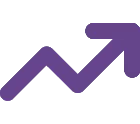SEO Case Study: How LinkGraph Reached Page 1 for a Competitive SEO Keyword in Just 3 Months
Ranking for high-value keywords in the SEO space can be very challenging. Not only are SEO brands and agencies competing against top search engine experts, most SEO […]
Ranking for high-value keywords in the SEO space can be very challenging. Not only are SEO brands and agencies competing against top search engine experts, most SEO keywords are extremely competitive to rank for and dominated by the same big brands (e.g. Moz, SEMrush, Ahrefs, etc.).
Prior to this SEO case study, LinkGraph had already earned moderate keyword rankings for our “Free SEO Audit,” landing page, but our SERP results were located primarily on page 2 and 3. As a result, those rankings drove minimal organic traffic to our website.
Our goal was to improve the performance of this particular landing page because of its proven results as a lead generation tool. We believed that enhancing the content-quality signals on the page could improve our rankings, even without aggressive link acquisition or digital PR promotion.
Spoiler Alert: We were right. In just 3 short months, LinkGraph got to page 1. We also improved organic traffic to the page by 468%.
Here’s how we did it.
But first…Some SEO Industry Context
Many SEO companies use free audits as lead generation tools. These audits identify the on-site and off-site factors that are impacting a potential client’s website, and then offer the results in exchange for an email address.
It’s no surprise then that according to Ahrefs’ Keyword Explorer, ranking for the keyword phrase, “free SEO audit,” is extremely difficult.
Because LinkGraph had already earned page 2 and 3 rankings for “SEO audit” related keywords, we knew that Google was accurately understanding the content and relevance of the landing page.
But the page did not have the necessary backlinks approximated by Ahrefs’ metric to reach page 1. Still, we did not focus on any backlink building in our strategy.
Instead we wanted to test whether improving content quality signals alone could have an impact on our SERP positions. We narrowed in on the on-page SEO factors that we could control, and directed our optimization efforts toward the landing page copy and design.
Step 1: Elevate Content Quality Signals on the Page
In order to improve content quality, our content strategists utilized LinkGraph’s SEO Content Assistant. They were tasked with the following:
- Improve semantic richness of the content by including more Focus Terms into the landing page copy (these are the terms, phrases, and topics our software generates for their relevance to the primary keyword target)
- Elevate topical depth of the content by increasing the word count from approximately 1100 words to over 2500
- Increase the content score of the landing page from 42 to 80+ (score on a scale of 100)
- Add additional content in a natural way that doesn’t impact readability
- Incorporate on-page SEO best practices with keyword inclusion in page titles, meta descriptions, and headings
Step 2: Incorporate New Content with Quality Web Design
After our strategists optimized the content and increased the word count of the landing page, our web designer went to work outlining a new information architecture. They prioritized the following design techniques:
- Add the additional copy in a natural way that does not disrupt the user experience or deplete the aesthetic quality of the landing page
- Maintain the text-to-image ratio by using features like vertical tabs, carousels, and expandable content modules
- Keep the location of the SEO audit text bar and subsequent lead capture form
A snapshot of LinkGraph’s redesigned “Free SEO Audit” landing page
SEO Case Study Results: Higher Keyword Positions and Increased Organic Traffic
Our content optimizations went live on January 1, 2021. Within two weeks, we started to notice results in Google Search Console.
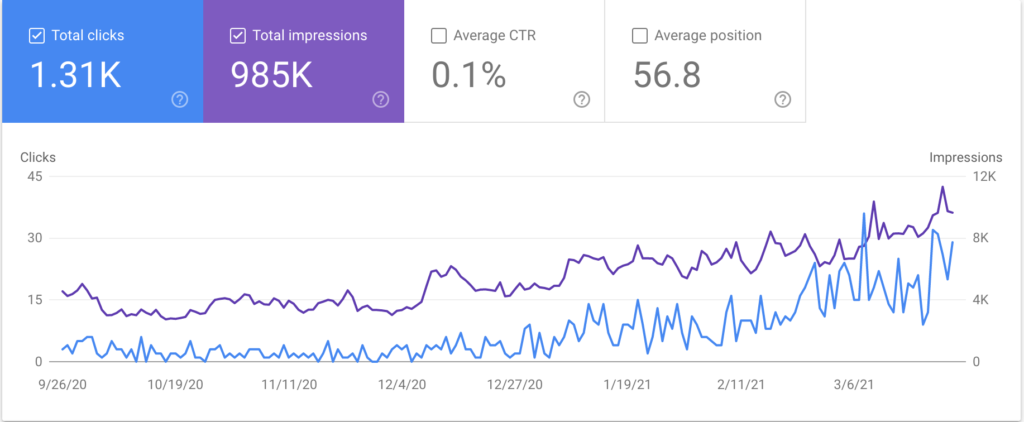
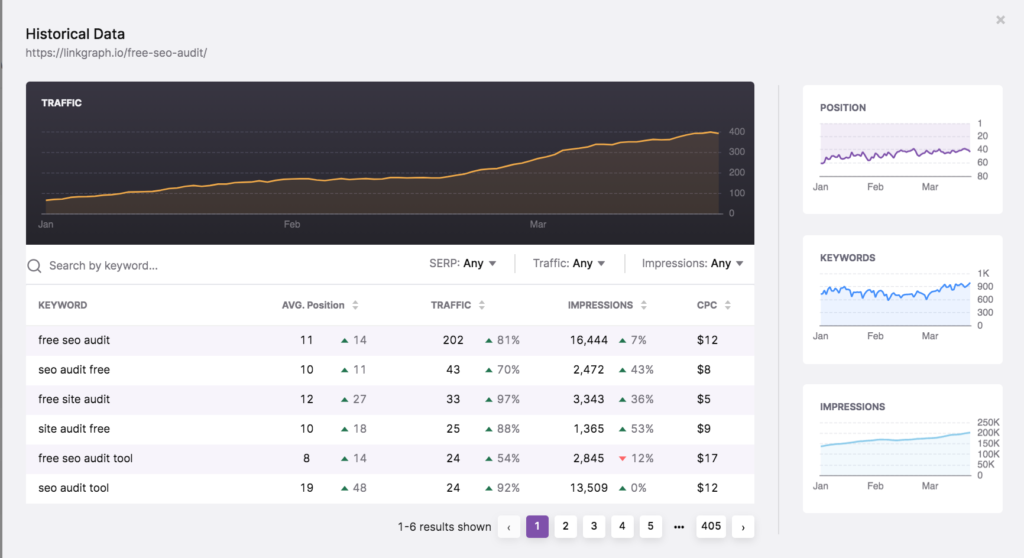
As stated earlier, LinkGraph had already earned keyword rankings for the landing page, but we were stuck on page 2 and 3 and getting very few clicks.
After our optimizations went live, our total number of keywords for the page actually remained static.
We think the reason we didn’t see any increase in total keywords is because we had already optimized for the most salient long-tail keywords the first time we created the page. But where we did see significant improvements was in our average position across all of those keywords.
Our average position across all keyword rankings for the page on January 1, 2021 was 61.
Our average position across all keyword rankings for the Page on March 30th, 2021 was 38.8.

By nature of these higher SERP positions, organic traffic naturally followed.
In the 3 months prior to the on-page optimizations, total organic traffic to the landing page was only 70 clicks.

In the three months after the content quality optimizations went live, total organic traffic was 398 clicks.

So where did these clicks come from? According to data from our GSC insights tool for January – March, the majority of those clicks came from the highly competitive keyword phrase: “free seo audit.”

Since publishing the new version of the landing page, our SERP result improved from page 2 to page 1 for the keyword phrase, “free seo audit.”
Although our rankings fluctuate daily on the first page, LinkGraph has ranked as high as the number 4 position, despite having only 7 backlinks to the landing page.
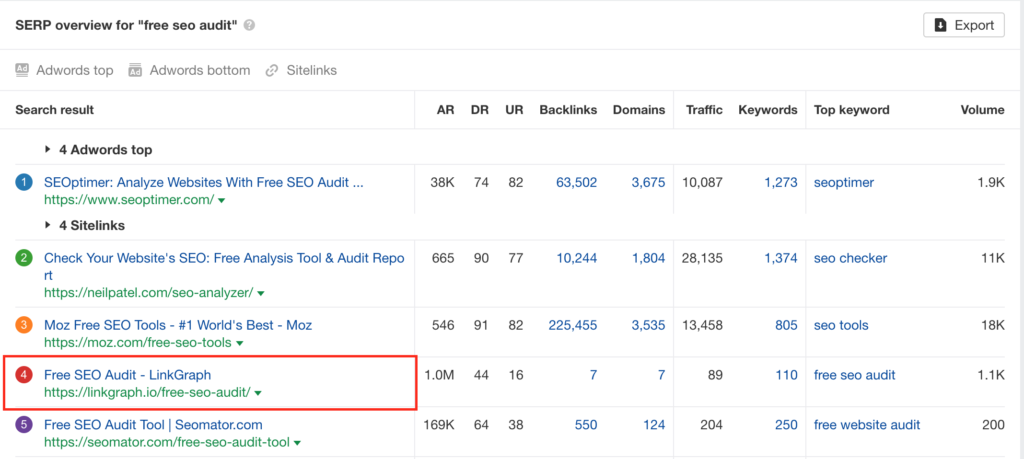
Remember that Keyword Difficulty score of 91?
Good thing we shot for the moon. 🙂
What Can We Learn From this SEO Case Study?
With any SEO strategy, it can be difficult to know exactly which optimizations resulted in improved SERP performance. Core algorithm updates, search volatility, and backlinks are all variables that can impact keyword rankings. However, by testing one variant at a time, and referencing the absolute truth of search engine data — Google Search Console — we can get a good sense of which of the optimizations we make to our websites are most or least effective.
In the case of our above example, here are some reasonable conclusions.
Content Quality Matters
High-quality, relevant content has always been Google’s end goal. All of the efforts Google’s engineers make to improve their algorithm stem from the desire to bring the best search results to users. By focusing on improving the content-quality signals on the page (and according to Google’s quality guidelines), LinkGraph started outranking competitors for a very valuable keyword in our industry niche.
Keyword Position > Total Keywords
In our case study, our total number of keywords for our landing page remained unchanged. However, because we were able to elevate our average SERP position across all of those keywords, we saw the bump in organic traffic that we were striving for. Although the total number of keywords is certainly important for overall impressions and growing your market share, when it comes to seeing those real clicks come in, you need to get to page 1.
Ahrefs’ Keyword Difficulty is an Imperfect Metric
Many site owners use Ahrefs’ Keyword Difficulty to shape their SEO strategy, but there are shortcomings to over-relying on this metric. The metric has an over-focus on the number of links to the landing page, which hasn’t been as predictive of good search performance as other metrics like content quality or the amount of PageRank. Google’s algorithms reward quality, meaning an emerging website can compete with the likes of the SERP-dominators, as long as they prioritize bringing the most useful, valuable content to users.
The unreliability of this metric actually led LinkGraph CTO, Manick Bhan, to create our own organic difficulty ranking in our Keyword Researcher tool. We don’t want site owners overlooking certain high-value keywords in their industries because they don’t believe that they can compete.
With the right SEO tools and quality-driven strategy, you can.
Google Search Console Data is Our most Powerful Tool
Our ability to accurately measure the impact of our optimizations is essential in refining our SEO strategy. The above case study relied heavily on our GSC Insights tool (which is built on top of Google’s API and gives you access to Google Search Console data for your site) in order to understand and evaluate the impact of our strategy.
By having granular data about where exactly our impressions and clicks come from, we can understand what works best to improve our SERP performance. Then, we can apply similar optimizations across the entirety of our web pages.
Popular Articles
Want access to the leading SEO software suite on the market?
See why the world's best companies choose LinkGraph to drive leads, traffic and revenue.
“They are dedicated to our success and are a thoughtful sounding board when we run ideas by them - sometimes on ideas and projects that are tangential to our main SEO project with them. Also, I love that they allow for shorter-term contracts compared to the usual 1-year contract with other SEO companies. Lastly, they deliver on their promises.”

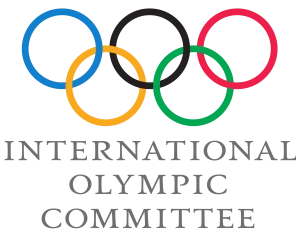



Enter your website URL and we’ll give you a personalized step-by-step action plan showing what exactly you need to do to get more traffic.
- Better tools
- Bigger data
- Smarter SEO Insights
Real-time SEO Auditing & Issue Detection
Get detailed recommendations for on-page, off-site, and technical optimizations.

